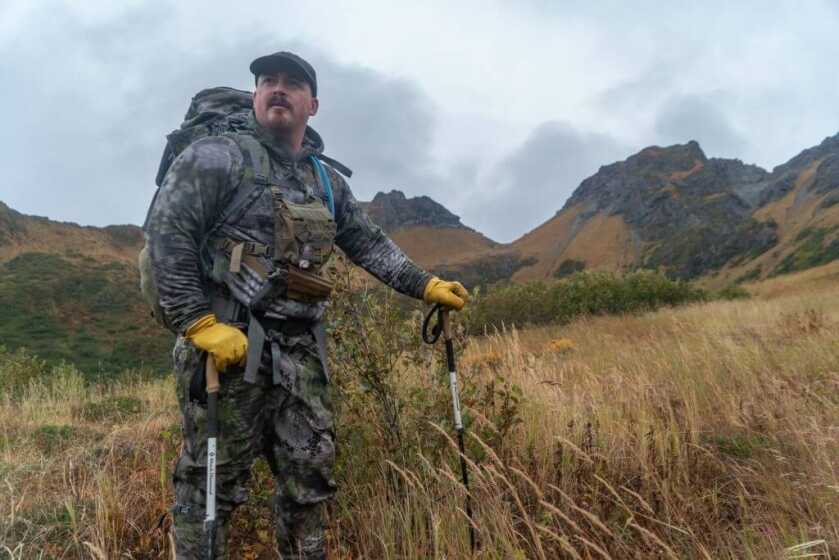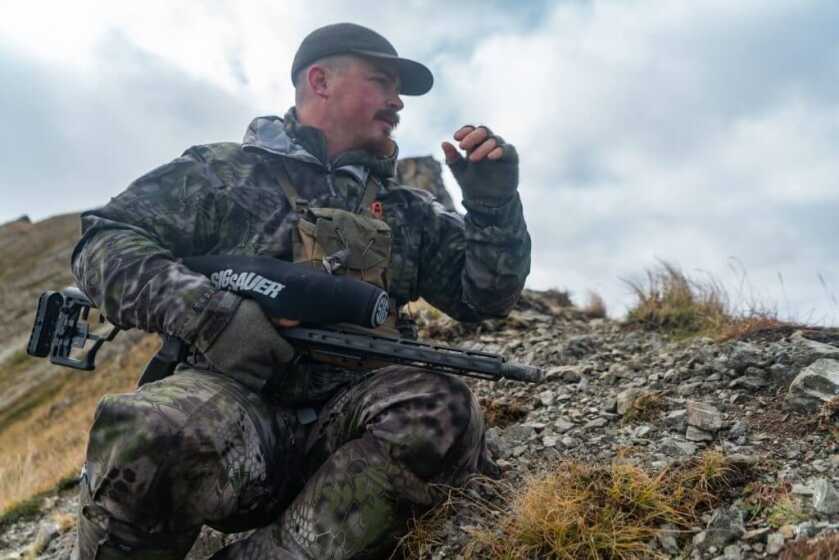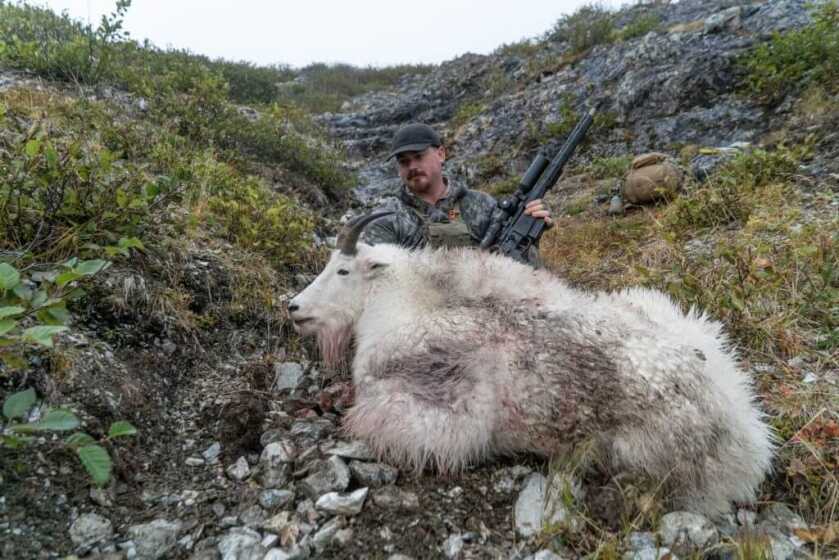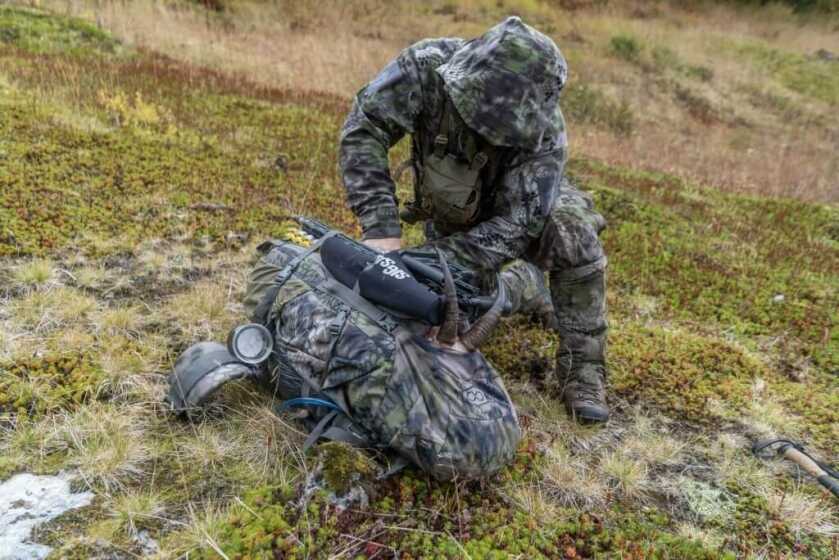I’d never worn waders on a big game hunt before, but here I was, with my Simms, trudging up a knee deep stream that smelled faintly of rotting salmon. The creek bed offered us a route into the canyon that postponed the alders but put us more or less exactly where I expected to encounter a brown bear. I did my best to remind myself that although the bears on Kodiak could reach 1,500lbs, they tended to be fairly congenial as long as they had bellies full of fish.
After a mile or so, we crossed out of the creek and hung our waders and boots in a tree. Jordan Budd was on the camera and it was raining a bit so she kept the electronics in her pack and prepared for the climb. Most of the leaves were off the salmonberry brush, which made visibility slightly better, and also showed just how many thorns were to be had on the devil’s club. Leather gloves soaking wet wrapped tightly on trekking poles collapsed to their lowest setting, we started the climb.

Steep country and mountain goats go together. The goats are built for rocky cliffs where few other animals can maneuver. Their feet are much more square than a deer or elk, and besides a hard edge on the outside of the hoof for holding onto the smallest of ledges, the rest of their foot is spongy and soft for increased traction. They are larger in their shoulder than their hindquarter, which aids both in climbing and descent. A mountain goat who has followed a ledge too far can actually do a handstand and turn around rather than back out, and they are capable of jumping short distances between ledges but cannot outrun much of anything on flat ground, so the cliff is their defense against predators. They make much of their living by eating the carbohydrate-rich lichen that grows on the rocks where they live. If you want to hunt them, you need to be able to go where they are, and that means climbing.
For the first 1,500’ feet we fought the brush hard. My guide, Will, ninja’ed through the alders with skill and grace while I took a more direct approach involving harsh language and dead reckoning. Jordan followed in the wake of broken limbs and muddy streaks in the hillside where the grass gave way. If the next person was three steps in front of you their feet would be at your eye level, at five steps they disappeared into the brush completely. I realized that if a brown bear did charge through this dense vegetation there wouldn’t realistically be time to draw and fire the Sig 10mm I carried in a chest holster, but the gun was a comfort. If ever there was a test for rain gear, climbing in the wet and thorny brush with frequent falls and slides had to be it, besides sweating like a draft horse at a barrel race, I was doing good.

We cleared the brush on a ridge that wrapped three sides of a basin with a broken peak in the center and within seconds I started seeing mountain goats, their snow white hair standing out against the slate gray of the rocks. Big white dot next to a little white dot didn’t even rate optics, but the single goat in the middle of a rock face that seemed navigationally impossible warranted a closer look. As it turned out all we saw there were nannies and kids, women and children. At elevation now, we started to work our way around the basin through a low pass to be able to glass more country. We spotted more goats as we hiked, and I was grateful for my stabilized binoculars, I could see what I needed to see with one hand while one trekking pole dangled from my wrist and the other provided my third point of contact.
There was a sense of urgency on this hunt. Mild weather in coastal Alaska is only ever temporary. The bruised looking clouds over the pacific showed us what we already knew from the forecast, a hurricane was building in the gulf of Alaska, and winds of 90mph were forecasted to hit the island tomorrow. Three of us had goat tags and we were broken into two teams. We really need to get at least one on the ground today, because there was no assurance we would get another chance. The eastern wind freshened a bit and started surging through the basins at about 30mph. As we climbed into a new area I started doing math on wind drift with the 150gr bullet I was firing from my Cross rifle in 277 Sig Fury. Its BC is .500 and velocity 2780 FPS from the 16’ barreled gun. The conclusion to my math problem: I wasn’t going to be shooting a long ways in this wind.
From another ridge we spotted several goats bedded on precipices chewing their cuds. Goats regurgitate their food and chew it again while resting in order to make it easier to digest. A nice billy laid on a rock at about 340 yards, there were gusts and calm spells in the wind as the storm approached, and although the shot was more than doable, unless he died instantly and didn’t roll off his perch, he would have fallen over a thousand feet, destroying himself on the way down. Making sure that scenario didn’t play out was one of my highest priorities. Firing a shot at an animal means taking responsibility for everything thereafter, and shooting an animal in a place like that is irresponsible.

We filmed the billy for a while, ate some snacks and a sandwich and glassed an immense amount of country. We could see mountains and goats that we simply didn’t have the time to move on, and rather than gamble on this billy feeding into an area where I could take an ethical shot, we shouldered packs and climbed into a new area to look for other goats.
Mountain goats were introduced to Kodiak Island in the 1950’s and have done very well, so well in fact that on portions of the island people can hunt two goats on one tag. Interestingly, in areas of the United States where goats have been introduced, the populations handle hunting much better than in areas where they are native. The species, Oreamnos americanus, is distinctively North American, and crossed the Bearing Land Bridge at least 25,000 years ago. There is no known fossil record of them anywhere else in the world, but the origin of their species is thought to be Tibet or Mongolia. Their long dense wool allows them to survive in temperatures as low as -50 Fahrenheit and in winds up to 100mph. They were less concerned about the approaching storm than I was.
From a new vantage I was able to glass back roughly one mile towards the top of the broken peak and saw seven goats bedded on a knife ridge, the one on the right looked like a billy and the spotting scope confirmed he was what we were after. Will and Jordan and I talked about options and decided to gamble on Mountain Goat psychology. They would be able to observe part of our approach but goats are confident in the cliffs, they’ve lived their whole lives where they can escape predators by going where nothing else was willing to go. It was going to be steep, falling had the severest of consequences, and that is exactly what we came for.
Ascending an avalanche chute and utilizing goat trails, we approached the knife ridge near the peak. A few yards from the top I became what we refer to in military terms as “fixed.” That means I was unable to move in any direction. My pack, loaded with gear, prevented me from looking up the hill far enough to know what was above me, and every piece of solid-looking rock I could reach crumbled when I gripped it. Looking downhill between my splayed out legs I whispered to Jordan, “I’m stuck.”
After making a weak attempt to suppress a giggle at my position, Jordan talked me into places I could move first my right foot then my left until I had down-climbed into a place where I could move across the face of the cliff into a fresh approach. Later she’d tell me she was glad not to be where I had been. We summited the ridge then tucked into a corner in the rocks. A nanny and her kid walked up the knife ridge to within 11 yards and inspected us before casually climbing down the portion of rock I had been unable to climb up. We glanced over the rock we hid behind to try to locate the billy. Three nannies lay bedded 30 yards away, and another goat lay a short ten yards to our left. We suspected he was the billy but getting high enough above the rock to see him meant exposing ourselves to the nannies and potentially causing a goat stampede into an oblivion of steepness and losing any opportunity at a shot.
We waited and looked out over the ocean into a dark sky and watched the clouds racing past the edge of the island. I took those minutes to let the situation sink in and appreciate the awesomeness of where I was and what I was doing and who I was with. I have rushed the finish line on many hunts where only afterwards did I realize the best moments were the ones right before the shot. The infinite uncertainty of everything that was about to happen compared with the amazement of sitting on a mountain with my friend Jordan, a good rifle in my hands, and an animal born for the steep and cold I never believed I would have the chance to hunt— it was somewhere between too much to take in and just enough. Then the billy stood up and walked onto the grassy sidehill. To be honest, I was so excited and focused on the shot I couldn’t tell you how far away he was— archery range to say the least. As a guide, I’ve seen more close shots missed than long ones, and as a shooter I make sure that everything is as right as I can make it on every shot I take. The goats were aware of us, but not alarmed. I placed the lid of my pack on the rock, turned the magnification on my scope to 5X, pushed the safety lever vertical, and settled my body into the rock. The billy paused and I broke the shot. He staggered a few yards and started to go down then regained his feet unsteadily. Then he was facing downhill and gaining momentum which could turn into the situation I feared most. I broke a second shot and he started sliding on the grass downhill and gaining speed, he flipped once as he fell into an avalanche chute then came to rest in the broken rock below without damaging his meat, hide or horns.


That moment was emotional, what followed was mechanical. We took some pictures, skinned him, with Will meticulously fleshing as we went, boned the meat out and placed it in bags, shouldered our packs and headed down the mountain with my rifle folded neatly beneath the skull of my billy. On another mountain on a different part of the island. We crossed the knife ridge in a notch that made it easier than the place where I had gotten jammed up earlier, descended into a basin and made camp for the night. The next day we down-climbed through the brush, put the waders back on and walked out the creek, pausing at the bottom to look back at the broken peak where you could still make out white specks slowly moving across the impossible. Then the mountain and its goats vanished behind wind driven clouds as the storm crashed into Kodiak Island as we walked across bear tracks in the gravel bars of the creek, humbled and grateful.


This was a great read James. Chasing mountain goats has been a dream for me since I saw my first one up Hurricane Creek many years ago. Thanks for the great story and sharing your experience!!
Great story! I have a friend that hunts goats on many continents and would really enjoy this story, as he could relate to the difficulties more than I and would, no doubt, rekindle many memories of his hunts. Thanks for sharing.